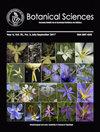从淡水分子系统发育角度研究巴氏杜林虫的时间尺度教训
IF 0.7
4区 生物学
Q3 PLANT SCIENCES
引用次数: 0
摘要
背景:恐龙的进化模式是复杂的,需要对物种的发育和形态、生态学、进化和遗传学进行全面的分类学研究。问题:根据校准过的Kryptoperidiniaceae的系统发育树,D. baltica从墨西哥到淡水的过渡是多久?研究的物种和资料描述:波罗的海杜林藻,Kryptoperidiniaceae和已知的dinotoms(内共生硅藻寄主dinophytes)化石记录。研究地点和日期:2010年至2019年,墨西哥城Xochimilco。方法:采用贝叶斯推断构建系统发育系统,采用松弛时钟法对宿主序列进行标定。结果:获得了宿主18S rDNA区和内共生体rbcL区基因序列。nitzschia型内共生体在遗传上不同于具有相同硅藻类型的其他恐龙组的内共生体。相比之下,考虑到已知的杜林斯基淡水物种,宿主之间的遗传关系是强大的,并且是最近起源的。墨西哥序列的古老与霍奇米尔科盆地的地质起源相吻合,这表明恐龙的进化史与它们所居住的地理区域有关。结论:我们的进化情景与校准的系统发育表明,在霍奇米尔科盆地,波罗的海杜林斯基向淡水的过渡具有地质背景。霍奇米尔科湖盐度的历史环境变化与波罗的海菌最初在微咸环境中的定居和随后对淡水的适应相对应。本文章由计算机程序翻译,如有差异,请以英文原文为准。
Timescale lessons of Durinskia baltica (Kryptoperidiniaceae, Dinophyta) from freshwater through a molecular phylogeny
Background: The evolutionary pattern of dinophytes is complex and requires comprehensive taxonomic studies addressing the species' development and morphology, ecology, evolution, and genetics.
Questions: How recent was the transition of D. baltica from Mexico to freshwater based on a calibrated phylogeny tree of the Kryptoperidiniaceae?
Studied species and data description: Durinskia baltica, Kryptoperidiniaceae and the known fossil record of dinotoms (endosymbiont diatom-host dinophytes).
Study sites and dates: Xochimilco, Mexico City. 2010 to 2019.
Methods: Phylogenies were constructed with Bayesian inferences and host sequences were calibrated with a relaxed clock method.
Results: We obtained genetic sequences of the 18S rDNA sector in the host and the rbcL sector in the endosymbiont. The Nitzschia-type endosymbiont is genetically distinct from endosymbionts of other dinotomes with the same diatom type. In contrast, considering the known freshwater species of Durinskia, the genetic relationship between hosts is robust and of recent origin. The antiquity of the Mexican sequence coincides with the geological origin of the Xochimilco basin, suggesting particularities in the evolutionary history of dinotomes linked to the geographic regions they inhabit.
Conclusions: Our evolutionary scenario with a calibrated phylogeny indicates that the transition of Durinskia baltica to freshwater in the Xochimilco basin is geologically contextualized. The historical environmental change of Lake Xochimilco with respect to salinity corresponds with an initial colonization of D. baltica in a brackish environment and its subsequent adaptation to freshwater.
求助全文
通过发布文献求助,成功后即可免费获取论文全文。
去求助
来源期刊

Botanical Sciences
Agricultural and Biological Sciences-Plant Science
CiteScore
1.90
自引率
21.40%
发文量
71
审稿时长
16 weeks
期刊介绍:
Botanical Sciences welcomes contributions that present original, previously unpublished results in Botany, including disciplines such as ecology and evolution, structure and function, systematics and taxonomy, in addition to other areas related to the study of plants. Research reviews are also accepted if they summarize recent advances in a subject, discipline, area, or developmental trend of botany; these should include an analytical, critical, and interpretative approach to a specific topic. Acceptance for reviews will be evaluated first by the Review Editor. Opinion Notes and Book Reviews are also published as long as a relevant contribution in the study of Botany is explained and supported.
 求助内容:
求助内容: 应助结果提醒方式:
应助结果提醒方式:


